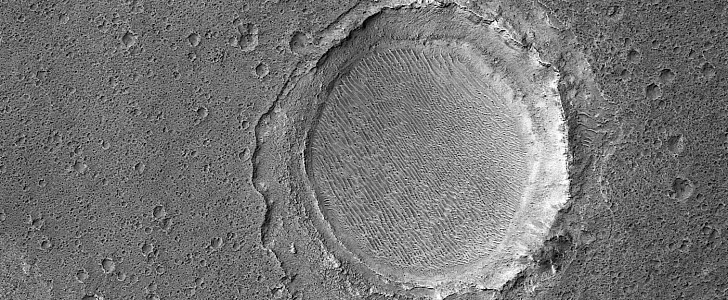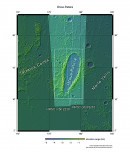Just like our planet, neighboring Mars is getting bombarded with space rocks of various shapes and sizes almost on a daily basis. It is estimated that more than 200 asteroids worth taking into account hit the Red Planet each year, and have done so for possibly millions of years.
With no vegetation or some other kind of features capable of hiding the results of these impacts, which would be the craters, Mars appears as a very scarred world. Perhaps not as scarred as say the Moon, on account of it being twice the size in diameter than Earth’s natural satellite, but still very much so.
You only have to look at the main pic of this piece (click main photo to enlarge) and you immediately realize that. The biggest feature to be seen here is the large crater that dominates the image, as seen from an altitude of 279 km (173 miles) by the HiRISE camera fitted on the Mars Reconnaissance Orbiter (MRO).
Taken all the way back in 2015 and recently republished by NASA and the University of Arizona, the photo shows this impressive, gladiator arena-shaped crater “oddly nested in a shallow depression,” sitting at the edge of what scientists believe to be a mud flow region.
Humans cannot yet explain how the crater and its surroundings came to look like this, and speculate that “maybe the flow surrounded the crater, and then partially drained.” Studying these areas, they say, gives humans “a more detailed look at the relations of these interesting features.”
And speaking of surroundings, dozens of smaller craters can be seen all around the large one.
Sadly, the University of Arizona does not say in what region of the Red Planet this impact crater can be found, but we are told the scale of the image: less than 5 km (3.1 miles) across.
You only have to look at the main pic of this piece (click main photo to enlarge) and you immediately realize that. The biggest feature to be seen here is the large crater that dominates the image, as seen from an altitude of 279 km (173 miles) by the HiRISE camera fitted on the Mars Reconnaissance Orbiter (MRO).
Taken all the way back in 2015 and recently republished by NASA and the University of Arizona, the photo shows this impressive, gladiator arena-shaped crater “oddly nested in a shallow depression,” sitting at the edge of what scientists believe to be a mud flow region.
Humans cannot yet explain how the crater and its surroundings came to look like this, and speculate that “maybe the flow surrounded the crater, and then partially drained.” Studying these areas, they say, gives humans “a more detailed look at the relations of these interesting features.”
And speaking of surroundings, dozens of smaller craters can be seen all around the large one.
Sadly, the University of Arizona does not say in what region of the Red Planet this impact crater can be found, but we are told the scale of the image: less than 5 km (3.1 miles) across.







